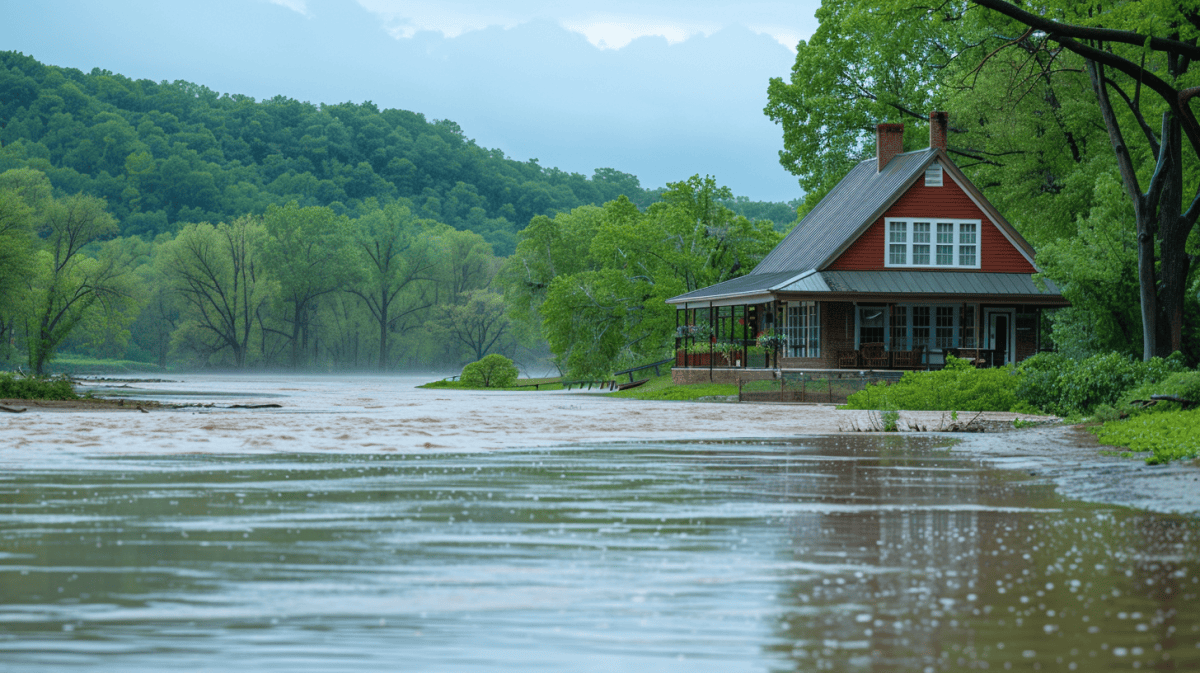Summer storms bring heavy rain and strong winds, posing unavoidable risk to homes and yards. Each year, countless properties suffer water damage during these months but there are steps that you can do to help reduce the impact of flooding, seepage, and other problems caused by the water getting inside your house. This article outlines five key strategies to shield your home from such damages — from maintenance routines to emergency plans.
Do You Own Your Home Or Rent?
- Clean your gutters and downspouts to prevent water from pooling around your house.
- Trim trees and remove any branches hanging over your home to reduce property damage risks.
- Install a sump pump in your basement to keep it dry and protect against flooding.
- Secure outdoor items so storms don't turn them into hazards, and use sandbags in flood-prone areas.
- Review your insurance policy for flood coverage, set up a water leak detection system, and have an emergency plan ready.
The Importance of Preparing For Summer Storms
Storms can hit hard and fast, especially in summer, so prepping your home for bad weather is essential to protecting it from water damage.
While an individual tornado or tropical storm can be unpredictable, we know that summer weather can be violent and damaging. This means that you have plenty of time to prepare ahead of time. That won't stop the storm from hitting your town or promise that your house will avoid damage, but there's a big difference between being devastated and simply being frustrated.
The important thing to remember here is that protecting your home from damaging weather isn't just a single task to mark off your list. It is a continual series of chores that you need to pay attention to all year round. The following are our top ten things homowners should do to protect against water damage from summer storms. We've also included a cost estimate, though that can vary widely based on size of your property, time of year, and location.
| Action | Description | Estimated Cost |
|---|---|---|
| Inspect and repair roof | Check for and repair any missing, loose, or damaged shingles to prevent water from seeping into the house during a storm. | $200 - $1,200+ depending on damage |
| Install a new sump pump | A sump pump in the basement can be used to pump out water that may accumulate during heavy rainfall, preventing flooding and subsequent damage. Depending on the age of your home, the pump may be tool old to function properly or not fully capable of pumping water fast enough. | $500 - $1,300+ for installation |
| Clean gutters and downspouts | Ensure gutters and downspouts are free of debris to allow water to flow away from your home's foundation, reducing the risk of basement flooding and damage. | $100 - $300 annually |
| Ensure proper soil grading | Adjust the landscape so that the ground slopes away from your home, directing water away from the foundation to prevent water damage. | $1,000 - $3,000+ depending on yard size |
| Seal windows and doors | Check and seal any leaks around windows and doors to prevent water from entering during storms. | DIY - $100 - $300 per window for professional repair |
| Install backwater valves | Prevent sewage from backing up into your home during heavy rainfalls by installing backwater valves on all pipes entering the house. These are also called backflow preventers or backflow valves. | $1,500 - $2,000 per valve including installation and parts |
| Waterproof the basement | Apply waterproofing sealant on the interior and exterior walls of the basement to prevent moisture entry. | $2,000 - $6,000+ |
| Install gutter guards | Add guards to prevent leaves and debris from clogging gutters, ensuring smooth water flow during rainstorms. | $500 - $2,000+ |
| Check and repair foundation cracks | Inspect the foundation for cracks and make necessary repairs to prevent water infiltration. | $250 - $800+ per crack |
| Keep valuable items on higher floors or shelving | Elevate valuable items to higher floors or raise them off the basement floor to avoid water damage in case of flooding. Use high quality plastic bins to prevent water intrusion. Make sure to stack the heaviest items on the bottom, as these containers will float in a flooded basement. This can cause the stack to topple if not placed correctly. | Cost varies on storage solutions. |
Water damage services can come in and help you to restore the structural elements of the basement if that's possible. But before they get there, you need to try and make sure that you get rid of the water that's been building up and clear out your stuff that's there too. Also, checking insurance coverage annually ensures you're ready for whatever the weather brings and that you have time to adjust coverage to best protect your family. It's not just about avoiding damage, it's about reducing the impact and being ready to respond quickly if something major happens.
Develop an Emergency Response Plan
Creating an emergency response plan is key to keeping your home safe during summer storms. It ensures you and your loved ones know what to do if a storm hits.
- List all contact information for family members, local emergency services, and your insurance agent. Keep this list in your phone and on paper in your emergency kit.
- Gather supplies for an emergency kit. This should include non-perishable food, water, flashlights, batteries, a first-aid kit, and any necessary medications.
- Identify safe places in your home where you can take shelter during a storm. Avoid areas with windows or large glass doors.
- Check that drainage systems around your home are clear of debris to prevent flooding.
- Install sump pumps or use other green infrastructure solutions like green roofs and permeable pavements to manage excess water.
- Prepare the exterior of your house by securing loose items that could become projectiles during high winds.
- Ensure gutters and downspouts are clean and functioning properly to direct water away from your home’s foundation.
- Confirm that your insurance covers damage from storms and flooding, potentially lowering costs through proactive measures.
- Create a plan for pets so they're safe and accounted for during emergencies.
- Discover how soil health around your property can affect water absorption and adjust landscaping as needed to prevent water damage.
These steps will guide homeowners through creating a detailed emergency response plan that addresses protection against flooding, securing the property, ensuring personal safety, and managing potential fire hazards effectively during summer storms.
Additional Measures to Prepare for Summer Storms
Want to keep your home safe from summer storms? Good move. It's not just about the big steps; small ones matter too. Keeping drains clear and cutting down risky branches are key moves.
Plus, checking out weak spots in your roof and pipes can save you a headache later. Think about adding a system to tell you if water's leaking...it could be a game changer.
Maintain Gutters and Downspouts
Keeping your gutters clean stops water from pooling around your house. This move keeps the foundation safe during heavy summer rains.
- Clean gutters and downspouts twice a year, especially after fall leaves drop and before summer storms hit.
- Use a sturdy ladder to reach gutters, ensuring it's securely placed on even ground for safety.
- Remove leaves, twigs, and any debris using gloves; this prevents blockages that can lead to water damage.
- Check for signs of rust or holes in gutters that may need repair or replacement to handle rainwater efficiently.
- Ensure downspouts direct water at least 10 feet away from your home’s foundation to avoid pooling and potential damage.
- Install gutter guards as a preventive step to keep debris out; this means less cleaning and better flow of water.
- Inspect gutter alignment—gutters should slope towards downspouts for optimal water flow without standing water.
- Seal any leaks with waterproof sealant to prevent water from dripping down exterior walls, which protects siding and foundations from moisture damage.
- Verify that all securing devices are intact so gutters are firmly attached even during strong winds and heavy rains common in snowstorms.
- After maintenance, flush gutters with a hose to ensure clear pathways for rainwater, checking that water flows freely through downspouts.
These steps save time and money by keeping homes dry and secure throughout stormy summer months.
Trim Trees and Remove Overhanging Branches
Trimming trees and removing overhanging branches is key to protecting your home during summer storms. This proactive step reduces the risk of property damage.
- Identify weak limbs and branches that could fall on your house. Look for signs of disease or decay.
- Use the right tools like saws, pruners, or chainsaws for efficient cutting.
- Keep a 10-foot clearance between your home and tree branches to prevent damage.
- Cut branches overhanging your roof carefully to avoid injury and property damage.
- Clean up all cuttings from your yard to keep it safe and tidy.
- Hire professionals for tall trees or complex jobs to ensure safety.
- Check local regulations about tree trimming in your area before starting work.
- Estimate the best season for trimming trees in your region, usually late fall to early spring.
- Clear all debris from gutters after trimming to ensure proper water flow away from your home.
- Educate yourself on proper pruning techniques to encourage healthy tree growth without risking future overhangs.
These steps are surefire ways to minimize storm-related water damage by keeping trees and branches in check around your home's exterior.
Set Up a Water Leak Detection System
Putting in a water leak detection system is key to protecting your home from water damage. These systems can find leaks fast, even the ones you can't see behind walls or under floors.
They work by monitoring moisture levels and sounding an alarm when something's off. This lets you fix leaks before they turn into big problems. When included as part of your smart home system it can even alert you remotely so that you can notify a friend to check on your home even if you are traveling during summer vacation with your family.
For best results, place sensors near places where leaks like to start—under sinks, near appliances, and by your sump pump. Some advanced systems also shut off your home's water automatically if they detect a major leak.
This feature could save you from coming home to a disaster after a storm. Getting this setup might seem like extra work now, but it will give you peace of mind during summer storms and beyond.
Summer Storms Can Cause Damage, But It's Better To Be Prepared!
Get your home summer storm ready. Clear gutters and downspouts. Trim trees. Secure outdoor furniture. Review insurance for storm coverage. Acts like these save your home from water damage during storms.
Simple steps today stop big problems tomorrow. Keep your house safe, dry, and standing strong through every summer storm.

